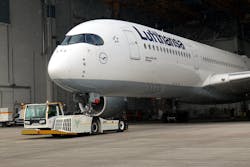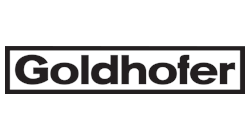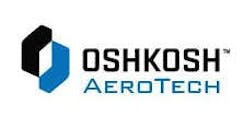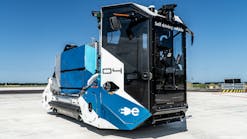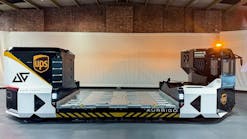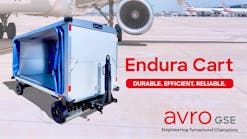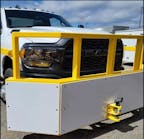Goldhofer delivered its first PHOENIX E, an electric towbarless aircraft tractor, to Lufthansa LEOS, at Frankfort Airport in December 2021. A couple of years prior, a prototype of the PHOENIX E was unveiled at inter airport Europe 2019.
“The challenge for the Goldhofer engineers was to develop and produce an electric version to match the existing diesel tractor in performance, design and handling,” says Rüdiger Dube, head of product management.
The challenge was met using the Goldhofer’s tried-and-tested IonMaster Technology, a 700V lithium-ion battery system with active thermal management.
The PHOENIX (AST-2), representing the company’s fourth generation of towbarless tow tractors and introduced in 2015, is considered the flagship among Goldhofer’s tow tractor fleet. The versatile tractor meets the requirements in pushback and long-distance towing for the full range of today’s aircraft with a maximum take-off weight of 352 tons. The flagship is capable of handling passenger and cargo aircraft on the market from the ERJ170 to the B777. With a 220 kW direct drive, towing speeds for maintenance tows are up to 32 km/h.
Sustainability
The PHOENIX E, the electric version of the PHOENIX tractor, caught the attention of the German Sustainability Award Foundation, which listed the all-electric tractor as a finalist for 2021 German Sustainability Award.
At Goldhofer, sustainability is a focus for not only products but for all business areas and activities, according to Dube.
“This applies not only to the quality of our durable and highly efficient products and solutions, but also to the manufacturing processes themselves and to our services such as training, maintenance and repair,” Dube says.
“Goldhofer offers purely battery-electric alternatives for the new generation of aircraft tow tractors in the Airport Technology product portfolio. In addition to the PHOENIX E towbarless tractor, this also includes the conventional aircraft tractor BISON E and our cargo tractor SHERPA E. So zero-emission ground support on the airport apron is now a reality,” he continues.
“At the same time, we are committed to sustainability with regard to the services we provide. A rapid response – through our local facilities and agents around the world and our web store in the case of spare parts – makes long downtimes a thing of the past. Our customers and we, ourselves, are also very happy with our online training courses and online support for maintenance work using smart glasses, all of which brings enormous savings in travel expenses.”
Electric vs. Diesel
In addition to “outstanding total vehicle efficiency and availability with the highest level of zero-emission performance,” Dube says the PHOENIX E has enormous potential for real energy savings compared to conventional tow tractors.
One of the advantages of the PHOENIX E is lower operating costs. According to Dube, up to 40 percent energy cost savings based on an annual operating time of 2,500 hours and up to 30 percent less maintenance cost is possible. Maintenance intervals are extended because the electric drive does not have idling components like the diesel version does. The electric drive also is less complex and has fewer parts than diesel. Less maintenance means less downtime.
The e-version comes with Goldhofer’s IonMaster Technology, which allows short charging times and supports quick opportunity charging. The PHOENIX E can be charged at all standard AC and DC charging points. It takes just 30 minutes, for example, to charge a 66 kWh battery from 20 to 80 percent in the case of opportunity charging at a fast DC charging station with a charging capacity of 70 kW.
One of the keys to long battery life is the temperature management system (TMS) that is a part of the Goldhofer IonMaster Technology. With its cooling compressor and heater, it ensures that the battery temperature is always in the optimum range between 15 and 40 C. Dube says this system adds 25 percent to the range of the vehicle and increases the battery’s life significantly.
The modular battery concept in the PHOENIX E starts in the basic version with 66 kWh. The battery system can be extended depending on performance requirements up to 165 kWh.
In addition to an all-electric model, a hybrid solution is available with 66 kWh battery capacity and a range extender.
Not all benefits related to savings can be easily measured in numbers.
“The most frequently heard feedback from our customers during all test drives and demo operations was that the PHOENIX E adds substantial value and comfort for the aircraft tractor operator,” Dube says. “This is a significant upgrade to the workplace in terms of operator health and mood.”
Future-ready
The PHOENIX E is designed to meet the demands of both today and tomorrow, according to Dube.
“We at Goldhofer are convinced that true sustainability is only possible if our products are technologically sophisticated and are reliable in every respect,” Dube says. “With our groundbreaking Goldhofer IonMaster Technology, we are able to offer durable, economical vehicles with incredibly high operational readiness and outstanding performance, and thus future-oriented.”
Furthermore, Dube says ground handlers can look forward to Goldhofer’s new LINK IoT platform, which combines effective telematics, monitoring and condition-based maintenance tools for Goldhofer products and solutions. The LINK IoT platform has been launched with the first basic monitoring information and will be expanded step by step.
